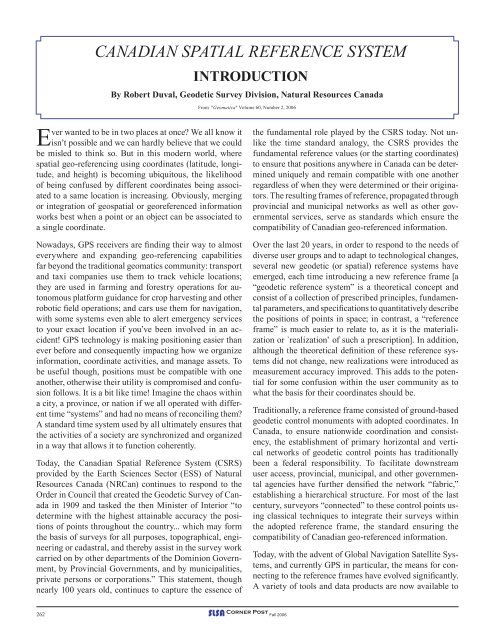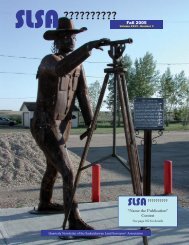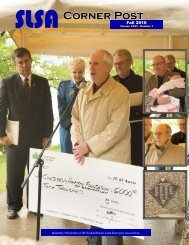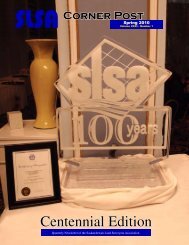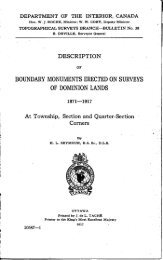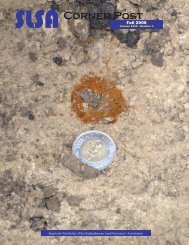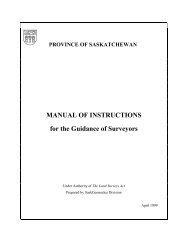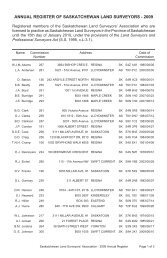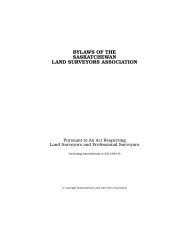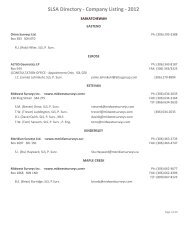CANADIAN SPATIAL REFERENCE SYSTEMINTRODUCTIONBy Robert Duval, Geodetic Survey Division, Natural Resources CanadaFrom "Geomatica" Volume 60, Number 2, 2006Ever wanted to be in two places at once? We all know itisn’t possible and we can hardly believe that we couldbe misled to think so. But in this modern world, wherespatial geo-referencing using coordinates (latitude, longitude,and height) is becoming ubiquitous, the likelihoodof being confused by different coordinates being associatedto a same location is increasing. Obviously, mergingor integration of geospatial or georeferenced informationworks best when a point or an object can be associated toa single coordinate.Nowadays, GPS receivers are finding their way to almosteverywhere and expanding geo-referencing capabilitiesfar beyond the traditional geomatics community: transportand taxi companies use them to track vehicle locations;they are used in farming and forestry operations for autonomousplatform guidance for crop harvesting and otherrobotic field operations; and cars use them for navigation,with some systems even able to alert emergency servicesto your exact location if you’ve been involved in an accident!GPS technology is making positioning easier thanever before and consequently impacting how we organizeinformation, coordinate activities, and manage assets. Tobe useful though, positions must be compatible with oneanother, otherwise their utility is compromised and confusionfollows. It is a bit like time! Imagine the chaos withina city, a province, or nation if we all operated with differenttime “systems” and had no means of reconciling them?A standard time system used by all ultimately ensures thatthe activities of a society are synchronized and organizedin a way that allows it to function coherently.Today, the Canadian Spatial Reference System (CSRS)provided by the Earth Sciences Sector (ESS) of NaturalResources Canada (NRCan) continues to respond to theOrder in Council that created the Geodetic Survey of Canadain 1909 and tasked the then Minister of Interior “todetermine with the highest attainable accuracy the positionsof points throughout the country... which may formthe basis of surveys for all purposes, topographical, engineeringor cadastral, and thereby assist in the survey workcarried on by other departments of the Dominion Government,by Provincial Governments, and by municipalities,private persons or corporations.” This statement, thoughnearly 100 years old, continues to capture the essence ofthe fundamental role played by the CSRS today. Not unlikethe time standard analogy, the CSRS provides thefundamental reference values (or the starting coordinates)to ensure that positions anywhere in Canada can be determineduniquely and remain compatible with one anotherregardless of when they were determined or their originators.The resulting frames of reference, propagated throughprovincial and municipal networks as well as other governmentalservices, serve as standards which ensure thecompatibility of Canadian geo-referenced information.Over the last 20 years, in order to respond to the needs ofdiverse user groups and to adapt to technological changes,several new geodetic (or spatial) reference systems haveemerged, each time introducing a new reference frame [a“geodetic reference system” is a theoretical concept andconsist of a collection of prescribed principles, fundamentalparameters, and specifications to quantitatively describethe positions of points in space; in contrast, a “referenceframe” is much easier to relate to, as it is the materializationor `realization’ of such a prescription]. In addition,although the theoretical definition of these reference systemsdid not change, new realizations were introduced asmeasurement accuracy improved. This adds to the potentialfor some confusion within the user community as towhat the basis for their coordinates should be.Traditionally, a reference frame consisted of ground-basedgeodetic control monuments with adopted coordinates. InCanada, to ensure nationwide coordination and consistency,the establishment of primary horizontal and verticalnetworks of geodetic control points has traditionallybeen a federal responsibility. To facilitate downstreamuser access, provincial, municipal, and other governmentalagencies have further densified the network “fabric,”establishing a hierarchical structure. For most of the lastcentury, surveyors “connected” to these control points usingclassical techniques to integrate their surveys withinthe adopted reference frame, the standard ensuring thecompatibility of Canadian geo-referenced information.Today, with the advent of Global Navigation Satellite Systems,and currently GPS in particular, the means for connectingto the reference frames have evolved significantly.A variety of tools and data products are now available to262 SLSA Corner Post <strong>Fall</strong> 2006
maximize the efficiency and the benefits of these moderntechnologies. Additionally the widespread availability oflow-cost GPS equipment in the consumer market is rapidlyincreasing the user base for geo-referenced information.Along with these changes comes the increased potentialfor incompatible coordinates due to the diversity of referenceframes available. It is therefore important not only tofacilitate the user’s access to these reference frames butalso to provide information about them, including theirtime-evolution and the related impacts on their geo-referencedinformation. This is an objective of this SpecialIssue of Geomatica.In concert with these new developments, the possibility ofintegrating directly into a stable global reference frame isalso becoming reality through applications such as PrecisePoint Positioning. Although this new ability is appealing,the requirement to maintain consistency with the adoptedreference systems for Canada, the North American Datumof 1983 (NAD83) and the Canadian Geodetic Vertical Datumof 1928 (CGVD28), continues to be a priority. Thelegacy left by the monumented geodetic infrastructurestill requires that relationships between old and new referenceframe realizations be clearly established to maintaincoordinate traceability over time. Additionally, the desireto maintain stable coordinates for control points that aremonumented on the surface of our “restless planet” requiresthat reference frame options be available to minimizedisruption to the general users while also meeting theneeds of more demanding user communities.Another fundamental role also played by the CSRS is itscontribution to the determination of underlying dynamicparameters of the Earth such as its orientation and rotationrate in space as well as its gravity field. These parameters,determined from the collective effort of the internationalgeodetic community, are not only critical to the efficientexploitation of modern space-based technology for positioningand navigation but are also enablers behind thetechnology itself. Furthermore, monitoring variations inboth the Earth’s geometry and its gravity field, essentialto the maintenance of the reference frames, also contributesto a better understanding of regional and global geophysicalprocesses linked to natural hazards and globalchange.The use of reference frames provided through the CanadianSpatial Reference System has extended from traditionalapplications in mapping and cadastral surveys to monitoringsea level rise, rectifying remote sensing imagery,measuring crustal uplift and subsidence, and interpretingseismic disturbances. However, the fundamental role theCSRS plays has not changed much over the years, and todayit continues to provide the means to ensure we can onlybe “in one place at one time!” In this Special Issue, papersauthored mainly by personnel from NRCan address differentaspects regarding the evolution of geodetic referencesystems in Canada as well as provide a look forward.Space Geodetic Techniques and the CSRS - Evolution,Status and Possibilities looks at the evolution of technologyover the past century, with particular emphasis on theadvent of navigation satellites during the past decades, andthe impact this technology has had on reference frame accuracyand access. Now that the positions (or, in a generalsense, the orbits) of navigation satellites are continuouslyestimated with centimetre accuracy and subsequentlymade publicly available through the Internet, a geodeticcontrol network has in essence been created in the sky. Asa result, our dependence on an infrastructure of groundbasedmonuments is increasingly being lessened. This newcapability is also giving rise to the development of newmethodologies for end users to achieve greater efficiencyand enhanced accuracy of their positioning informationwith respect to a common reference system.In The Evolution of NAD83 in Canada, the reader will beprovided insights into our national horizontal referencesystem including: the evolution of NAD83 from a horizontalto a three-dimensional reference frame, how it isnow linked to the dynamic International Terrestrial ReferenceFrame (ITRF), and how it is maintained using activecontrol points and episodic measurements of the CanadianBase Network. The improvement in NAD83 accuracy thatcame along with GPS is shown. Crustal movements drivenby geophysical processes, observed at regional and nationalscales and capable of affecting reference frame stability,are now apparent and their impacts are also discussed.A Gravimetric Geoid Model as a Vertical Datum in Canadagives readers a glimpse of how the vertical controlnetwork has developed nationally over time and how theadvent of space geodesy has led the Earth Science Sectorto initiate the “Height Modernization” project towards theadoption of a gravimetric geoid model as the new verticaldatum in Canada. The improvements in geoid modelling,in part attributable to the availability of data from recentlylaunched (CHAMP and GRACE) and upcoming (GOCE)satellite gravimetry missions, as well as the centimetre accuracyavailable for ellipsoidal height determination fromprecisely processed signals from navigation satellites, arethe major enablers behind this new direction. The anticipatedoperational benefits that stem from not having tophysically connect to a benchmark for precise height determinationare appealing from the perspective of both theuser and the provider of height information.284 SLSA Corner Post <strong>Fall</strong> 2006 263


